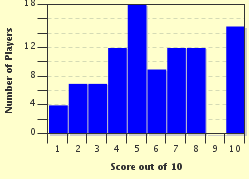Quiz Answer Key and Fun Facts
1. White of the eye, protects and encloses the eye's contents.
2. Jelly-like material forming most of the eye's volume.
3. Provides lubrication for the eye.
4. Contains blood vessels supplying the retina with oxygen and nutrients.
5. Clear covering at front of the eye which allows light in.
6. Ring of muscles that contract to control the amount of light entering the eye.
7. Adjusts shape to focus incoming light on the retina.
8. Part of the retina that is most sensitive to light.
9. Type of retinal cell which is used in detecting colour.
10. Transmits information from eye to brain.
Source: Author
looney_tunes
This quiz was reviewed by FunTrivia editor
rossian before going online.
Any errors found in FunTrivia content are routinely corrected through our feedback system.


